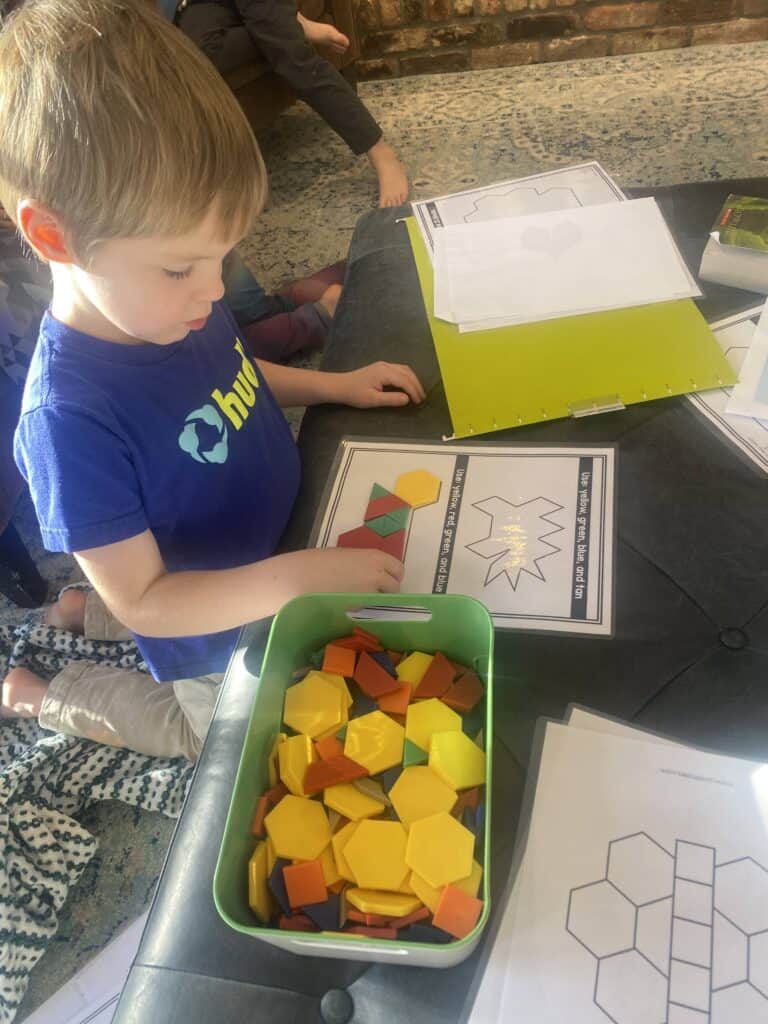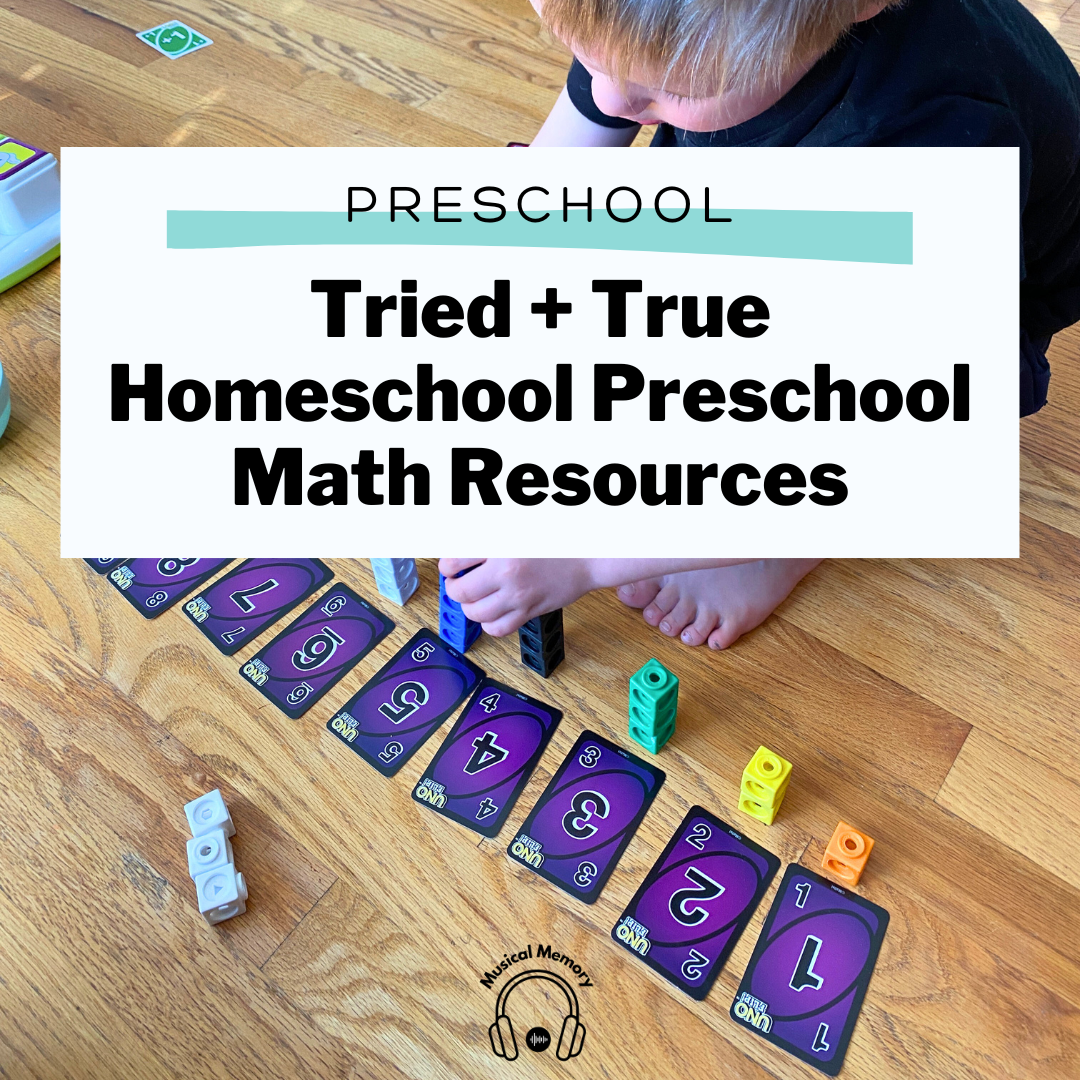If you want to actually learn how to teach math concepts, and you have young children under 6, I highly recommend this tiny book, Preschool Math at Home.
So far, it’s the only practical preschool math book I’ve found that teaches normal everyday parents like you and me how to teach math.
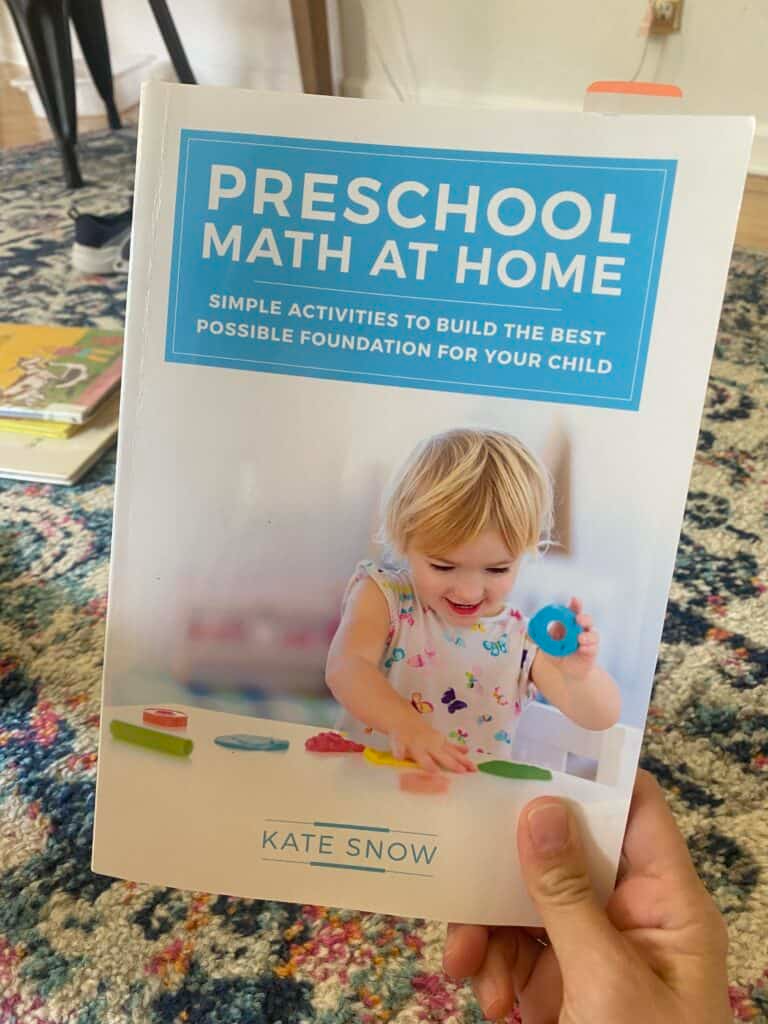
The author, Kate Snow, dispels all the myths surrounding “expert mindset” in math education. The modern education system says you need to be a certified preschool expert or math educator to teach preschool math.
NOPE! In fact, who is the leading expert in YOUR preschooler? You! You understand your kids’ adorable, unique speech impediments. You can sorta tell what they’re thinking right before they ask you a question. You know their strengths and weaknesses. You know what makes them tick and when they’re hungry and tired.
You know they are smart and curious and capable.
YOU are the most qualified person to teach your child. You just have to WANT to learn how. And I’m 100% certain you can.
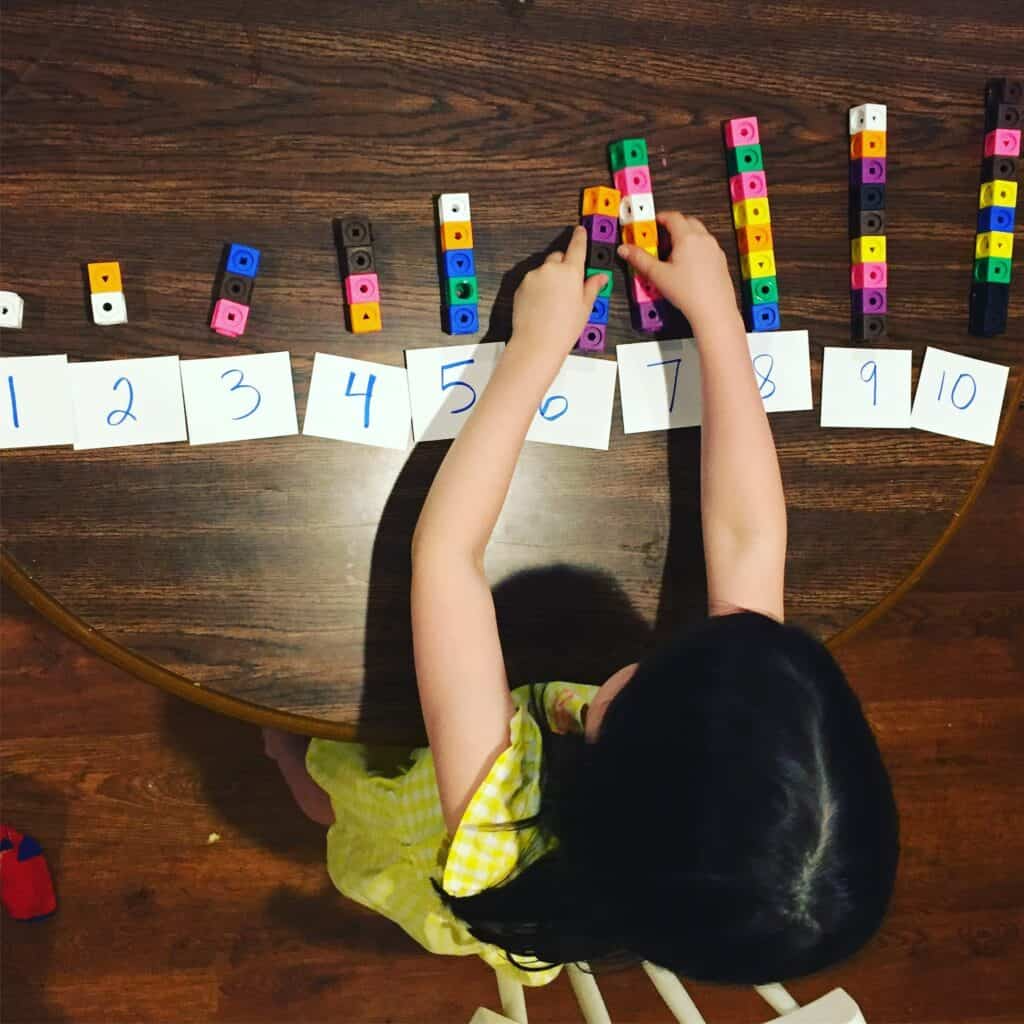
This preschool math book will help you gain immense confidence in early childhood math education. It’s really so rich and full that it’d be sufficient as a precursor to 1st grade math. If you take any 3-6 year old child all the way through the activities and they really understand what’s going on, then they’d be ready for 1st Grade Math With Confidence, which is one of my top 3 homeschool math programs. (It’s written by the same author as Preschool Math at Home.)
You could also choose to do Kindergarten Math with Confidence if you thought your child would benefit from more practice with some of the higher level skills.
Why I Love Preschool Math at Home
The intro alone is worth the book!! It explains the mathematical concepts your need to cover to give your kids a strong foundation in math.
Then, the rest of the math activities and math lessons will help you see how kids actually process and learn early math. You don’t need to do every single activity with a young student, though they’re mostly very simple.
You don’t need any formal “math lesson plans” or practice books or workbook based preschool math curriculum.
I’ve used this book in one way or another with each of my 4 big kids and plan to use it casually with my 5th as well. When my first child was 4, we did “special learning time with mommy,” during the last 30 min of younger siblings’ nap times a few days a week. I was pretty systematic in working through it.
I was less systematic about the program with the other kids because I knew the skills/ concepts I was looking for & could mostly incorporate them into regular conversation in daily life, though I would still use some of the cute card and dice games to practice for fun.
My first 4 kids were born in 5 years, so our day to day life was pretty full when my oldest 2 were preschool & kindergarten age. I loved that this little book allowed me to simple & effectively use everyday activities to help develop essential skills for number sense. It was one of the first books that really helped me to see how the best way to learn is often what’s most natural to the child.
Whether you end up following the pre-k math units in this book to a T or just using the interactive activities (like comparing numbers of goldfish on siblings’ plates, or calculating how many more cookies you need to make it fair), this hands-on approach to building foundational math skills is a GREAT WAY to lay a solid foundation for future math work.
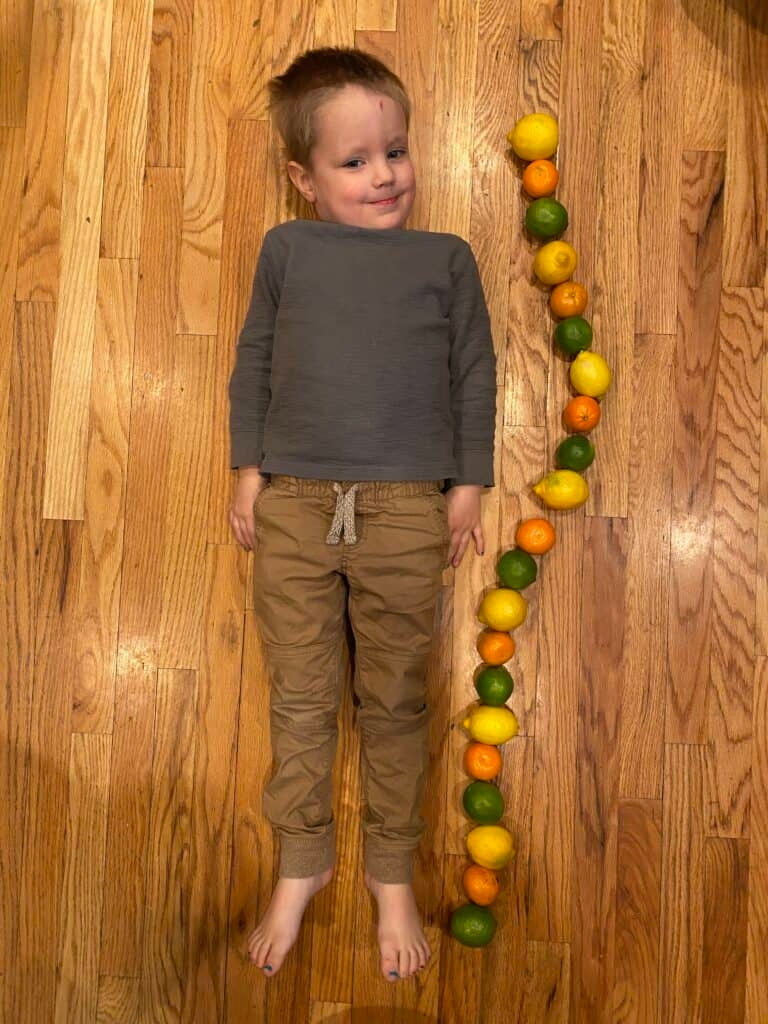
Materials Needed to Go with the Book
One of my favorite things about this book is that the required materials list is very minimal. Almost every single thing is probably already in your home! So simple.
I created a math kit of sorts and just put all the basics along in a basic plastic storage basket. I used ziplock baggies to store the counters and coins, along with some dot stickers, index cards, old game tokens & dice for when those materials were needed.
The basic supply list is:
- The book
- 20 counters (any small, simple object is fine… pennies, legos, plastic cubes, etc.)
- One nickel
- 10 pennies
- Blank paper & writing utensil
The random need-once-in-a-while math kit items are:
- 10 small toys (i.e. toy cars, animal figurines)
- 4 stuffed animals
- blanket
- 2 paper bags
- 2 regular 6-sided dice
- tape
- 2 different small objects for game tokens
- 2 different colored writing utensils
The optional supplies include:
- Play dishes & food
- Blank dot stickers
- Small food (goldfish, raisins, cheerios)
- Large index cards
- Small stickers
A Few Other Preschool Math Faves
I love love love 3-6 year olds. 5 is probably one of my all time favorite ages but 4 is a close second. One thing that is so fun about homeschooling is witnessing your kids’ ah-ha moments. Whether it’s during a formal instructional lesson, or more of a passing moment in the car or kitchen… seeing your kids make connections and grow in understanding is so rewarding.
One thing that works really well with a house full of kids (and my type B personality) is to keep activities and materials available and randomly leave them out for the kids to “discover” and just play with. They learn so much through play. Having sort of intentional items around for kids to play and create with (and read) really enhances the learning environment.
Charlotte Mason said “Education is an atmosphere, a discipline, a life.” Materials & mood in the house definitely promote an atmosphere of learning and curiosity.
Regarding math specifically, we keep a handful of mathy type toys, materials, and books around and we keep conversation about math pretty positive. Mindset & attitude around math in the early years really matter for your kids’ math studies down the road.

Here’s a list of math materials our 3-6 year olds have enjoyed over the years:
- Rekenrek (aka: small abacus) – if you only get one hands on math thing, get this!! It’s one of the best ways for kids to learn to visualize “making” numbers… how many makes 8? 5 and 3, 6 and 2, 7 and 1, 4 and 4. This activity is in Preschool Math at Home and I love using the rekenrek for this. I also love using the rekenrek for practicing and subitizing numbers (this is explained in Preschool Math at Home) and visualizing addition, subtraction, and skip counting.
- Balance scale – this exact one has lasted through 5 kids, lots of baby/ toddler destruction over 8 years.
- Pretend clock – same with this super cheap clock
- Coins!! – I got rolls of real coins from the bank years ago and we keep them all in a “piggy bank” made from an old peanut container. I cut a slit in the lid for the coins. The kids have all learned to count money with these coins, identify, make change, trade 2 nickels for a dime, count by 5/ 10/ 25, make $1.00, etc. 10/10 recommend real coins and playing pretend store, counting money for fun.
- Pattern blocks – we have these standard plastic ones in standard colors which is useful for pairing with math curriculums
- Pattern block card kit – we also have this fun kit that has lots of shape cards! We often used both pattern block kits simultaneously because my 4 oldest kids are all so close in age. You might not need 2 separate kits
- Rubberband boards – plastic or wooden, doesn’t matter. Kids think they’re fun! This has always entertanined my littles while I worked with bigs.
- Math printables pack – I created this digital packet when my 4th was in preschool because I’d used the same worksheets, tracing pages, templates for all my kids and people would ask – “Where did you get that part part whole mat or those ten frame cards!?” It includes all the printables you need for the preschool math at home and will also work well alongside any other math curriculum you need for K-2.

Start Singing Math Songs
Preschool is the perfect age to start singing cute little math songs. All of my kids have sung skip counting math facts songs starting around age 4 or 5. Then, once they were in 1st grade, 2nd grade and onward, they began to connect the dots between the seemingly random songs they’d memorized by rote and the concepts they were learning in their homeschool math curriculum.
Preschoolers and kindergarteners love to sing and hear familiar songs. You can read more about the power of intentional memorization in this post. Or just snag our math songs (or download our app on Apple or Android) and start playing them in the car today!! I promise it’ll pay off down the road.

The activities in this inexpensive little book have paved the way for my kids and me to acquire strong number sense and enjoy math. Now that my 12 year old is starting pre-algebra, I can look back and see that this book was one of the best early “formal academics” we stumbled on. (If you can even call it formal academics… because it’s full of hands-on activities that can fit anywhere in your family’s everyday life schedule. No complicated home instructor guide needed.)
It has helped each of my kids build a solid math foundation, even the ones who don’t just naturally tend towards mathematical thinking. Namely through helping me understand how kids learn math. We’ve learned to speak the language of numbers together and this foundational book was a crucial part of that!
You might also like:
- Ultimate Guide to Homeschool Preschool
- Is My Child Ready to Learn to Read? Reading Readiness Guide for Homeschool Parents
- Best Rhyming Books for Kids ages 3-7
- Daily Homeschool Routine
- Fine Motor Skills for Kids ages 2-5
